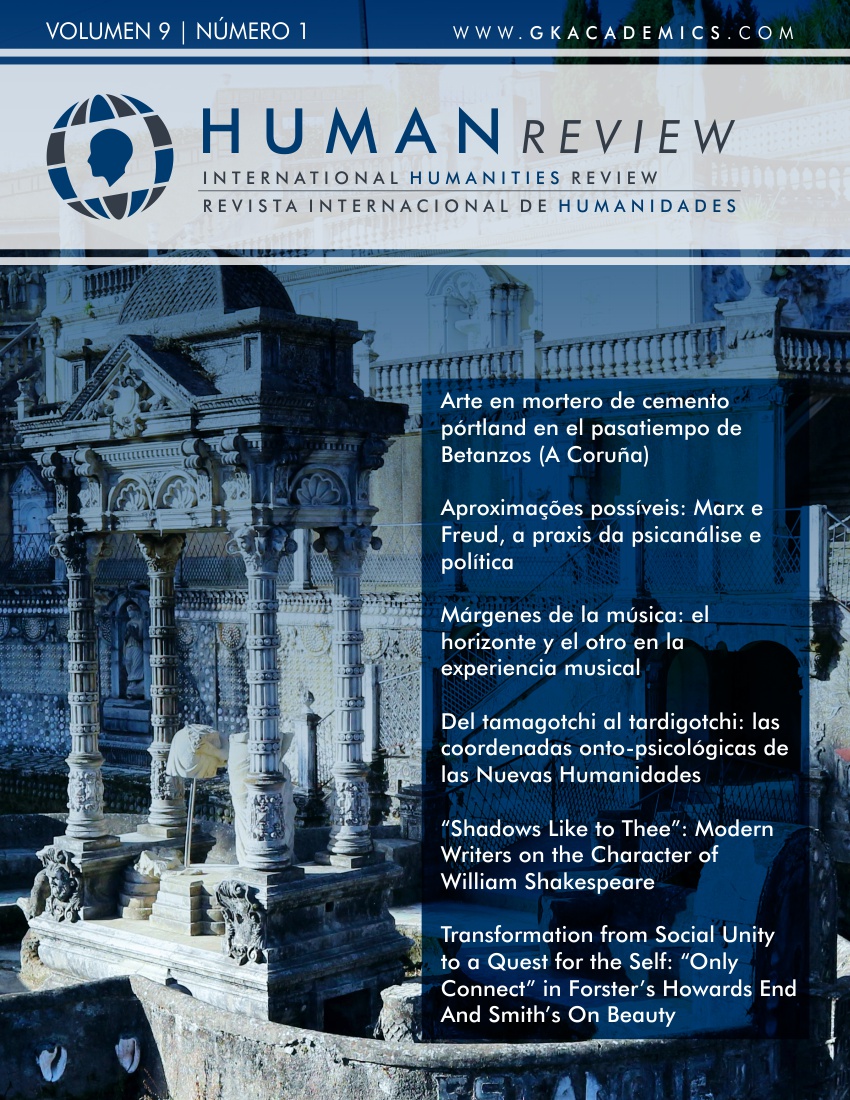From Tamagotchi to Tardigotchi: the Ontopsychological Coordinates of the New Humanities
Keywords:
Tardigotchi, Tamagotchi, New Humanities, Human Sciences, Technology, EcologyAbstract
The present article constitutes a metacriticism of Tardigotchi, as biological-technological hybrid product derived from Tamagotchi and as practice of objectual art, based on a transversal approach of diverse humanistic perspectives, i.e., the ontological, ethical, aesthetic and psychological ones. Hence the interpretation of the complex relations between Tardigotchi and its human genesis permits a discovery of the ontopsychological coordinates of Tardigotchi and the new humanities, and at the same time, the materialization of new reflections on the relations between materiality and humanity, among human sciences, technology and ecology.
References
Albaladejo, T. (1998). Del texto al texto: transformación y transferencia en la interpretación literaria. En: Estudios de lingüística textual: homenaje al profesor Muñoz Cortés (pp. 31-46). Murcia: Universidad de Murcia.
Assigana, E., Chang, E., Cho, S., Kotecha, V., Liu, B., Turner, H., Zhang, Y., Christel, M. G. y Stevens, S. M. (2014, Octubre). TF-CBT Triangle of Life: A Game to Help with Cognitive Behavioral Therapy. En: Proceedings of the First ACM SIGCHI Annual Symposium on Computer-human Interaction in Play (pp. 9-16). Nueva York: ACM. DOI: https://doi.org/10.1145/2658537.2658684
Bachelard, G. (2000). La formación del espíritu científico. Madrid: Siglo XXI.
Baudrillard, J. (2005). Cultura y simulacro. Barcelona: Kairós.
Campion, M. G. (1989). Technophilia and Technophobia. Australasian Journal of Educational Technology, 5(1), 23-36. DOI: https://doi.org/10.14742/ajet.2335
Carmagnat, F. y Robson, E. (1999). Qui a peur du Tamagotchi? Étude des usages d'un jouet virtuel. Réseaux. Communication-Technologie-Société, 17(92), 343-364. DOI: https://doi.org/10.3406/reso.1999.2126
Dawkins, R. (2006). The Selfish Genes. Nueva York: Oxford University Press.
Donath, J. (2004). Artificial Pets: Simple Behaviors Elicit Complex Attachments. En: M. Bekoff (Ed.). The Encyclopedia of Animal Behavior. Santa Bárbara: Greenwood Press.
Durand, G. (2004). Las estructuras antropológicas del imaginario. Introducción a la arquetipología general. México D.F.: Fondo de Cultura Económica.
Fallad, J., Hueso, E. J. y Ramírez, D. E. (2012). Psychological and Cultural Foundations Towards Technophilia and Technofobia. En: Tenth LACCEI Latin American and Caribbean Conference for Engineering and Technology. (pp. 23-27). Panamá: LACCEI.
Gadgil, M. (1993). Of Life and Artifacts. En: S. R. Kellert y E. O. Wilson (Eds.), The Biophilia Hypothesis (pp. 365-377). Washington: Island Press.
Guerrero, F. G. (1999). La cultura anestesiada del Tamagotchi. Rev. Asoc. Esp. Neuropsiq, 19(70), 245-249.
Herzog, H. (2002). Darwinism and the Study of Human-animal Interactions. Society and Animals, 10(4), 361-368. DOI: https://doi.org/10.1163/156853002320936818
Kahn Jr, P. H., Gary, H. E. y Shen, S. (2013). Children's Social Relationships with Current and Near‐future Robots. Child Development Perspectives, 7(1), 32-37. DOI: https://doi.org/10.1111/cdep.12011
Kellert, S. R. (1993). The Biological Basis for Human Values of Nature. En: S. R. Kellert y E. O. Wilson (Eds.), The Biophilia Hypothesis (pp. 42-69). Washington: Island Press.
Kellert, S. R. y Wilson, E. O. (Eds.). (1993). The Biophilia Hypothesis. Washington: Island Press.
Lamers, M. H. y van Eck, W. (2012, Abril). Why Simulate? Hybrid Biological-digital Games. En: Proc. Applications of Evolutionary Computation (pp. 214-223). Berlín/Heidelberg: Springer. DOI: https://doi.org/10.1007/978-3-642-29178-4_22
Lévi-Strauss, C. (1966). The Savage Mind. Hertfordshire: Garden City Press.
Lévi-Strauss, C. (1991). Totemism. Londres: Merlin Press.
Levy, D. (2010, Octubre). Falling in Love with a Companion. En: Artificial Companions in Society: Perspectives on the Present and Future (pp. 20-23). Oxford: Oxford Internet Institute. DOI: https://doi.org/10.1075/nlp.8.13lev
Marsden, P. S. (1998). Memetics: A New Paradigm for Understanding Customer Behaviour and Influence. Marketing Intelligence & Planning, 16(6), 363-368. DOI: https://doi.org/10.1108/EUM0000000004541
Noz, F. y An, J. (2011, Mayo). Cat Cat Revolution: An Interspecies Gaming Experience. En: Proceedings of the SIGCHI Conference on Human Factors in Computing Systems (pp. 2661-2664). Nueva York: ACM. DOI: https://doi.org/10.1145/1978942.1979331
Numaoka, C. (1997, Noviembre). Innate Sociability: Sympathetic Coupling. En: 1997 AAAI Fall Symposium on Socially Intelligent Agents (pp. 98-102). California: AAAI.
O’Rourke, A. (1998). Caring About Virtual Pets: An Ethical Interpretation of Tamagotchi. Animal Issues, 2(1), 1-20.
Pickering, A. (2009). Beyond Design: Cybernetics, Biological Computers and Hylozoism. Synthese, 168(3), 469-491. DOI: https://doi.org/10.1007/s11229-008-9446-z
Rolston III, H. (1993). Biophilia, Selfish Genes, Shared Values. En: S. R. Kellert y E. O. Wilson (Eds.), The Biophilia Hypothesis (pp. 381-414). Washington: Island Press.
Ronderos, N. (2000). Tamagotchi, la mascota virtual: la globalización y la sociedad de la simulación a través de una tecnología del ocio. En: E. Restrepo y M. V. Uribe (Eds.), Antropologías transeúntes (pp. 41-60). Bogotá: Instituto Colombiano de Antropología e Historia.
Stairs, D. (1997). Biophilia and Technophilia: Examining the Nature/Culture Split in Design Theory. Design issues, 13(3), 37-44. DOI: https://doi.org/10.2307/1511939
SWAMP. (2011a). Human+Tardigotchi_SWAMP and Tiago Rorke. Science Gallery Dublin. Vídeo recuperado de: https://www.youtube.com/watch?v=jqILkd54ENY. DOI: https://doi.org/10.1145/2341931.2341950
SWAMP. (2011b). Tardigotchi. Vídeo recuperado de: https://www.youtube.com/watch?v=81wOUUVwCFM&t=341s.
SWAMP. (2012). Tardigotchi. Leonardo, 45(4), 392-393. DOI: https://doi.org/10.1162/LEON_a_00424
Turkle, S. (2005). The Second Self: Computers and the Human Spirit. Cambridge: MIT Press. DOI: https://doi.org/10.7551/mitpress/6115.001.0001
Ulrich, R. S. (1993). Biophilia, Biophobia, and Natural Landscapes. En: S. R. Kellert y E. O. Wilson (Eds.), The Biophilia Hypothesis (pp. 73-137). Washington: Island Press.
van Eck, W. y Lamers, M. H. (2006, Septiembre). Animal Controlled Computer Games: Playing Pac-man Against Real Crickets. En: 5th International Conference on Entertainment Computing (pp. 31-36). Berlín/Heidelberg: Springer. DOI: https://doi.org/10.1007/11872320_4
van Eck, W. y Lamers, M. H. (2013). Hybrid Biological-digital Systems in Artistic and Entertainment Computing. Leonardo, 46(2), 151-158. DOI: https://doi.org/10.1162/LEON_a_00530
Varner, G. (2002). Pets, Companion Animals, and Domesticated Partners. En: D. Benatar (Ed.), Ethics for Everyday (pp. 450-475). Nueva York: McGraw-Hill.
Wilson, E. O. (1993). Biophilia and the Conservation Ethic. En: S. R. Kellert y E. O. Wilson (Eds.), The Biophilia Hypothesis (pp. 31-41). Washington: Island Press.
Wilson, E. O. (2003). Biophilia. Cambridge: Harvard University Press.
Downloads
Published
How to Cite
Issue
Section
License
Those authors who publish in this journal accept the following terms:
- Authors will keep the moral right of the work and they will transfer the commercial rights.
- After 1 year from publication, the work shall thereafter be open access online on our website, but will retain copyright.
- In the event that the authors wish to assign an Creative Commons (CC) license, they may request it by writing to publishing@eagora.org









